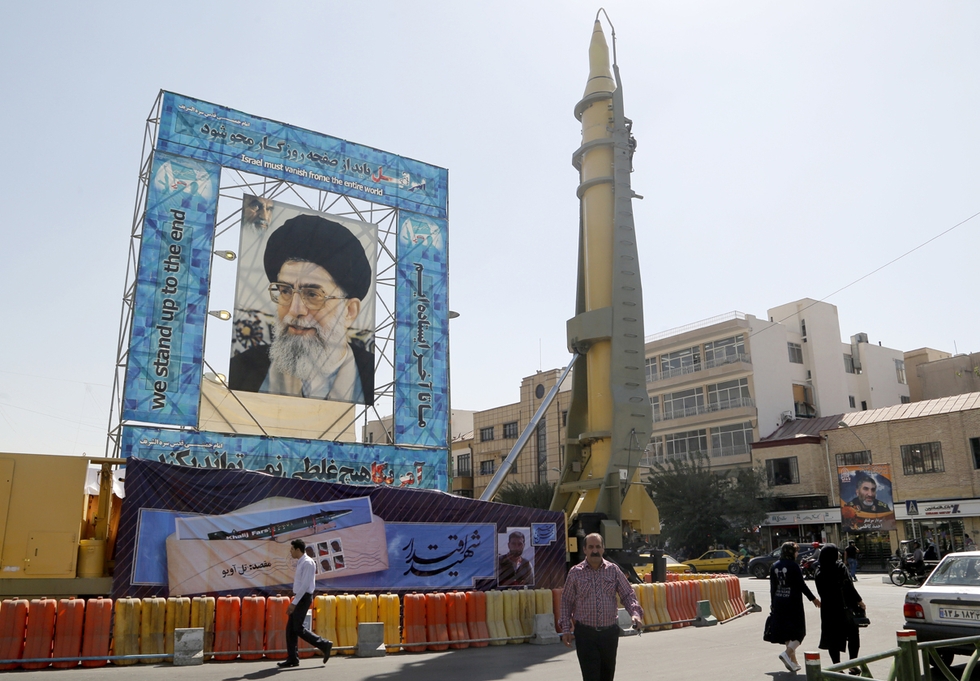Missile crisis: Trump's bullying tweets will not make Iran back down

After Donald Trump’s administration officially put Iran on “notice” over last Sunday's ballistic missile test, immediately followed by the imposition of new sanctions on Iran, there was a flurry of speculation on the likelihood of a rapid deterioration of US-Iranian ties to the point of military conflict.
In view of the ideological nature of the Trump administration, the potential for conflict is not negligible. Trump’s embryonic and chaotic national security team is dominated by ideologues who are extremely sympathetic to Israel and appear determined to cut Iran down to size.
Moreover, President Trump is on record for attacking the Joint Comprehensive Plan of Action (JCPOA), the nuclear deal between Iran and the Western powers championed by former president Obama, as the “worst deal ever negotiated”.
But the inexperienced Trump administration may have underestimated the sophistication of Iranian diplomacy and strategic planning. The geopolitical realities of the region have shifted considerably since the heady days of March-April 2003 when the US parked the bulk of its war machine in neighbouring Iraq.
READ: US imposes new sanctions on Iran and sends warship to coast of Yemen
In the aftermath of America’s political defeat in Iraq, the Islamic Republic considers itself the dominant power in the region and, short of triggering a shooting war, is not afraid of escalating tensions with the US even to the point of a major diplomatic crisis.
By testing the Trump administration so early, the Iranian defence and national security establishment has shown that it is fully attuned to the new realities and wants to take the lead in the emergence and management of bilateral tensions.
Ballistic missiles: Iran’s sole deterrence
The test firing of a medium-range ballistic missile by Iran is the Islamic Republic’s latest show of strength following the nuclear deal of July 2015.
Iran possesses one of the most extensive ballistic missile arsenals in the world and Iranian leaders consider the country’s advanced missiles programme as their sole deterrent against aggression by superior military powers like the US and Israel.
In short, the ballistic missiles programme is a legacy of the Iran-Iraq War and Iran’s continuing inability to develop state-of-the-art conventional forces. For example, the Iranian air force is one of the weakest in the region, with 40-year-old, US-supplied warplanes forming its backbone.
The ballistic missiles programme is a legacy of the Iran-Iraq War and Iran’s continuing inability to develop state of the art conventional forces
While Iran’s ballistic missiles programme was always viewed with suspicion by the West, it has come under even greater scrutiny since the signing of the JCPOA in summer 2015.
The American position appears to be that Iran’s continuing testing of ballistic missiles – both as a show of strength and as part of a long-term developmental process – is inimical to the spirit, if not the substance, of the nuclear accord.
For their part Iranian officials are insistent that the tests are neither in breach of the nuclear accord, nor UN resolutions inasmuch as Iran’s missiles are not designed to carry nuclear warheads.
The great worry in Iranian defence circles – particularly amongst the high command of the Islamic Revolutionary Guards Corps (IRGC) – is that post-JCPOA, the US will move stridently to curb Iran’s ballistic missiles programme, primarily through a combination of sanctions and diplomatic pressure.
These fears are well-grounded. It was precisely this combination of crippling sanctions and incremental diplomatic pressure which played a significant role in changing the calculus of Iranian leaders on their country’s nuclear programme, leading to the JCPOA. IRGC commanders are fearful that by exerting sufficient pressure, the US may succeed in forcing Iranian leaders to accept similar curbs on the missiles programme.
As part of a campaign to counter this threat, the IRGC insists on routine testing with a view to preserving the momentum of the missiles programme and maintaining military preparedness.
Furthermore, Revolutionary Guard commanders past and present continually showcase and defend the country’s missiles programme as part of a media strategy to shape domestic public opinion. The latest intervention is by former IRGC commander, and current military advisor to Iranian leader Ayatollah Khamenei, Major General Yahya Rahim Safavi, who claims that owing to its “indigenous” nature, the ballistic missiles programme is unstoppable.
Military confrontation?
Despite nearly four decades of deep political and ideological hostility, the United States and Iran have managed to avoid a major shooting war. There were brief military confrontations in the Persian Gulf in the final stage of the Iran-Iraq War, notably Operation Praying Mantis in April 1988, but these were localised operations which did not escalate into a broader conflict.
It is noteworthy that post-1988 similar clashes have been avoided despite the fact that the American navy and IRGC naval forces regularly come into close contact, often in adversarial circumstances. The last major incident occurred in January 2016 when the IRGC navy captured 10 US marines who had ventured into Iranian waters.
The Trump administration is mistaken if it believes that a ratcheting up of pressure will force an Iranian retreat in the region
Furthermore, IRGC speedboats regularly sail close to US warships, the latest significant incidents occurring in July 2016 and in January.
With the advent of the aggressive Trump administration, there is a danger that these relatively minor incidents could escalate quickly ,particularly if the Pentagon is ordered by the White House to radically alter the US navy’s rules of engagement in the Persian Gulf.
In a potentially ominous sign, White House press secretary Sean Spicer falsely accused Iran of attacking a US warship. Spicer appears to have confused the Yemeni Houthi attack on a Saudi warship for an imaginary Iranian attack on a US navy vessel.
READ: Few regrets: Saudi major general justifies 'ugly face' of Yemen war
However, there is another more cynical explanation, namely that the new US administration is deliberately conflating an attack on a Saudi military vessel by putative Iranian allies as a direct assault on US interests. This chimes with the latest belligerent rhetoric from senior Saudi military official and advisor to the defence ministry, Brigadier General Ahmad Assiri, that at a strategic level Saudi Arabia is fully coordinated with the US and expects greater pressure on Iran in 2017.
A rude awakening
The Trump administration is mistaken if it believes that a ratcheting up of pressure, coupled with closer policy alignment with Israel and Saudi Arabia, will force an Iranian retreat in the region. The Islamic Republic is too deeply entrenched in the region’s conflict zones to beat a quick retreat. By all credible accounts, Iran will stand its ground even if it risks a major crisis in US-Iranian relations.
In a sign of closing of ranks in Tehran, even Iran’s excessively polite and circumspect foreign minister, Mohammad Javad Zarif, has robustly responded to Trump’s latest outburst by claiming that “Iran is unmoved by threats” and that while the Islamic Republic will never initiate war, “we can only rely on our own means of defence”.
This echoes remarks by veteran Iranian diplomat and former foreign minister, Ali Akbar Velayati, to the effect that Iran will not yield to “useless” US threats. A leading conservative and advisor to Ayatollah Khamenei on international relations, Velayati’s pronouncements are widely regarded to reflect the position of the Iranian leadership.
If Donald Trump believes his idiosyncratic style of belligerent tweeting diplomacy will have the desired impact in Tehran, he is in for a rude awakening.
- Mahan Abedin is an analyst of Iranian politics. He is the director of the research group Dysart Consulting.
The views expressed in this article belong to the author and do not necessarily reflect the editorial policy of Middle East Eye.
Photo: A Ghadr-F missile is displayed next to a portrait of Iran's Supreme Leader Ayatollah Ali Khamenei at a war exhibition to commemorate the 1980-88 Iran-Iraq war at Baharestan square, south of Tehran on September 26, 2016. (AFP)
Middle East Eye propose une couverture et une analyse indépendantes et incomparables du Moyen-Orient, de l’Afrique du Nord et d’autres régions du monde. Pour en savoir plus sur la reprise de ce contenu et les frais qui s’appliquent, veuillez remplir ce formulaire [en anglais]. Pour en savoir plus sur MEE, cliquez ici [en anglais].




